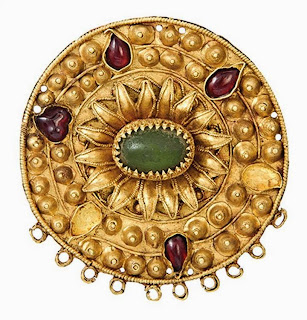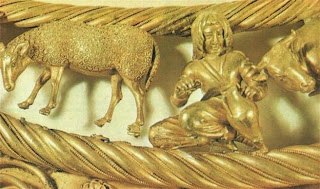 | A priceless collection of ancient gold artifacts from Crimea that was on loan to a Dutch museum when Russia annexed the region is still in legal limbo. The trove of Scythian treasures, which including a magnificent 4th century BC Scythian helmet, had been lent by several Crimean museums to the Allard Pierson Museum in Amsterdam when Russian forces seized control of the peninsular in March 2014. |  |
 | The Crimea and the Black Sea were and remain an important crossroads between Europe and Asia. The recorded history of the Crimean Peninsula, historically known as Tauris or Tauric Chersonese, begins around 500 BC when several Greek colonies were established along its coast. Crimea since that time has endured a long series of conquests and invasions. |  |
 |  |   |
 | .jpg) |  |
 | The modern history of Crimea began with the annexation by the Russian Empire in 1783. In 1921 the Crimean Autonomous Soviet Socialist Republic was created. This republic was dissolved in 1945. Since 1991 it has had the status of an Autonomous Republic within Ukraine until its recent annexation by the Russian Federation in the 2014 Crimean Crisis. |  |
 | Nearly a year after the exhibition “Crimea: Gold and Secrets From the Black Sea” wrapped up at the Allard Pierson Museum 565 rare treasures on loan from four Crimean museums remain in boxes in a storage facility, awaiting a court decision about where they should be shipped. “Russia is attempting to appropriate valuable exhibits from Crimean museums that are currently on loan abroad," Ukraine’s vice prime minister for social affairs, Oleksandr Sych, said during a news briefing. |
 | Construction of the Olympic venues in the Imereti Valley resulted in over a dozen archeological expeditions, and close to 400 artifacts have been handed over to the city's history museum. "The construction of the Olympic venues in Sochi over the past five years has triggered large-scale archaeological excavations previously unseen in this resort city," said Alla Guseva, Deputy Director for Research at the museum. |  |
 | In October 2013 the museum unveiled the Ancient Gold of Kuban and the Black Sea Region exhibition as part of the Cultural Olympiad's Year of Museums. This is the first exhibition to feature artifacts unearthed during the Olympic construction. The excavations in the Imereti Valley started in the wake of the Olympic construction. Previously, the area was considered unattractive for archeological expeditions. However, the first excavations have demonstrated that the area has been populated since ancient times. |  |
 |  The Bosporan Kingdom was an ancient state located in eastern Crimea and the Taman Peninsula, on the shores of the Cimmerian Bosporus (now known as the Strait of Kerch). |  |
 Gold Stater - Bosporan Kingdom | It was named after the Bosphorus, also known as Istanbul Strait, a different strait that divides Asia from Europe. The Bosporan Kingdom was the longest surviving Roman client kingdom. It was based on the export of wheat, fish and slaves. The profit of the trade supported a class whose conspicuous wealth is still visible from the newly discovered archaeological finds. |  |
 |  |  |
.jpg) |  |  |
 |  |  |

No comments:
Post a Comment